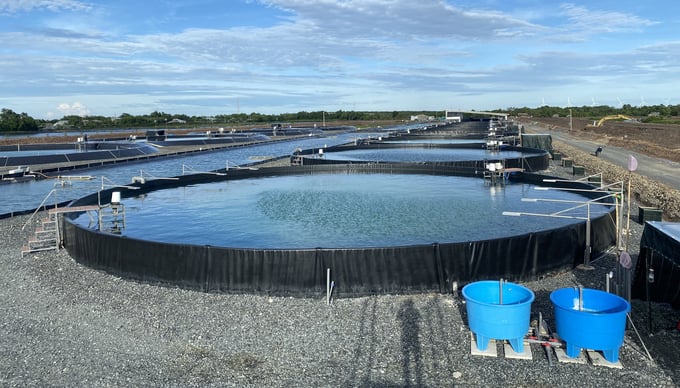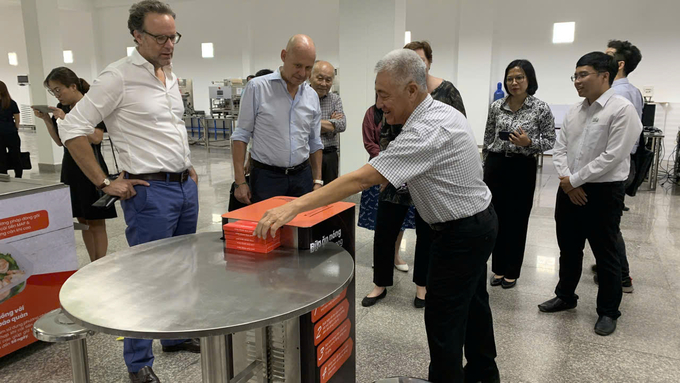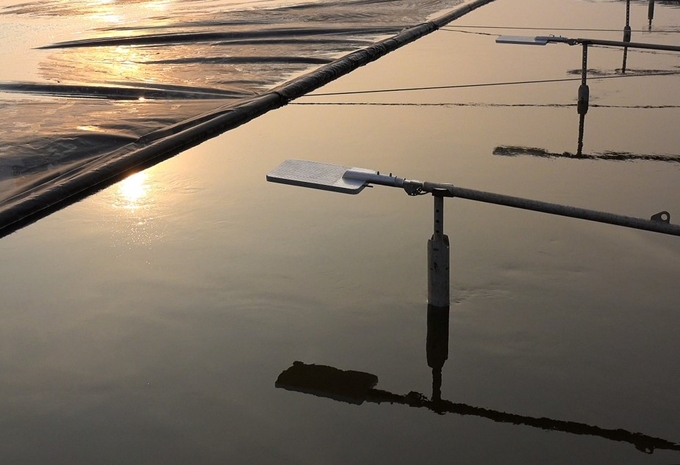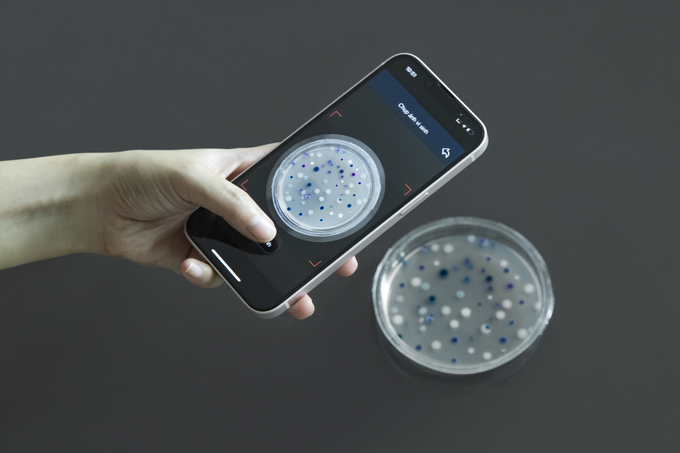June 17, 2025 | 12:48 GMT +7
June 17, 2025 | 12:48 GMT +7
Hotline: 0913.378.918
June 17, 2025 | 12:48 GMT +7
Hotline: 0913.378.918

The Tomgoxy model by Rynan Technologies Vietnam in Tra Vinh. Photo: Ho Thao.
According to the Department of Animal Health (Ministry of Agriculture and Rural Development), in the first nine months of the year, the disease situation in shrimp farming has been complex. Specifically, across the country, areas affected by white spot disease (1.034 ha), acute hepatopancreatic necrosis disease (1.009 ha), red body disease (643 ha), white feces disease (565 ha), stunted growth, and microsporidiosis are increasing rapidly.
These diseases are concentrated in key shrimp farming areas such as Tra Vinh, Soc Trang, Ca Mau, Bac Lieu, Kien Giang and sporadically in other provinces. Notably, white spot disease is causing major concern as there is no preventive vaccine and no effective treatment.
Aquatic researchers have stated that once shrimp are infected, there is little chance of curing them. Therefore, the application of technology to control disease outbreaks in shrimp farming has become an essential solution.

Dr. Nguyen Thanh My introduced the company's equipment for the shrimp industry to partners. Photo: Ho Thao.
Dr. Nguyen Thanh My, Chairman of My Lan Group, shared his thoughts on the ongoing disease issues in shrimp farming. He explained that, aside from a few minor factors, most shrimp farmers are unintentionally worsening disease outbreaks by employing incorrect practices.
One common mistake is the continuous operation of aeration machines 24/7 to supply oxygen to the shrimp, despite the fact that oxygen is already naturally present in the water. This practice not only wastes electricity but also increases costs and causes noise pollution in the area.
"The oxygen concentration in the water is 1g/l, while the machines provide 1.43g/l. Natural oxygen is already available at the bottom of the pond, so why continue using aerators to push oxygen up?" Dr. My explained.
Dr. My also pointed out significant disadvantages of using aeration fans. Firstly, when the fans are running, excess feed is dispersed in the water, leading to waste and difficulty in collecting organic matter. Secondly, the aerators spread airborne particles carrying pathogens from one pond to another, while also promoting bacterial growth at the bottom of the pond.

The LED lighting system is installed above the pond and turned on in the evening to stimulate the shrimp to feed. Photo: Ho Thao.
To solve these issues, Rynan Technologies Vietnam has applied a new shrimp farming method at their farm in Trà Vinh. The ponds are specially designed with a funnel-shaped bottom to create a unidirectional flow, which helps layer the water flow and accelerates the settling of waste at the bottom.
"In the ponds, there are organic wastes such as shrimp feces, leftover feed, shrimp shells, and dead shrimp. These wastes include both soluble (16.7%) and insoluble types. We manage this by using siphoning to remove the insoluble waste. The funnel-shaped bottom and unidirectional flow allow the waste to settle quickly, and by opening the valve, we can discharge the waste in a few minutes. This saves water and helps prevent diseases", explained Mr. My.
He further shared that during the day, shrimp typically feed in groups. Due to their feeding behavior, they tend to choose larger pellets and ignore the smaller ones. Therefore, from midnight, he turns on green lights to encourage the shrimp to consume algae and seaweed, promoting their growth.

AI technology helps detect diseases early in shrimp ponds and manage up to 90% of disease-related risks. Photo: Ho Thao.
To prevent disease outbreaks, Mr. My utilizes AI technology to automatically track the size and health of the shrimp, monitoring daily growth data to detect any early signs of illness. This AI-based system enables farmers to control disease risks up to 90%.
"In Vietnam, the average shrimp farming density is around 200 shrimp per square meter. However, with the technology I've developed, it is possible to double that density to 400-500 shrimp per square meter, all while still conserving energy and water", Mr. My explained. He added that the integrated siphon system helps mitigate the spread of disease in the ponds, and if any issues arise with the shrimp, the technology can immediately identify the problem, minimizing potential economic losses.
Mr. My believes that by applying the right techniques and scientific methods, the country's shrimp export target of 8.4 billion USD is within reach. What's more, he sees the potential for the industry to reach 15 billion USD in exports in the near future.
Dr. Nguyen Thanh My disagrees with the view that the cost of investing in the equipment is too high and only for the super-rich. According to him, although the initial investment cost is high, the system helps save energy, increase stocking density, and control up to 90% of disease risks, which means higher profits. This is suitable for collective economic models like cooperatives.
In fact, in Tra Vinh, the high-tech shrimp farming model is being implemented in Cau Ngang, Duyen Hai districts, and Duyen Hai town. The results show positive impacts on productivity, output, and economic efficiency, with more and more people boldly investing in developing the model. The average shrimp density has reached 100-200 shrimp per m², with an average yield of about 45-60 tons per hectare per crop, an increase of 10-20 tons per hectare per crop compared to 2017.
In the past, Mr. Le Van Tich, a shrimp farmer from Cai Gia Hamlet, Hiep My Dong Commune, Cau Ngang District, cultivated shrimp in earthen ponds. He encountered several persistent challenges, such as water pollution, unexpected disease outbreaks, and erratic weather conditions, all of which resulted in unstable and unpredictable harvests each season.
However, with the introduction of pond management technology, Mr. Tich can now monitor the water conditions in his shrimp ponds on an hourly basis. By simply tapping on his smartphone screen, he is able to access real-time data on critical water parameters, including temperature, dissolved oxygen levels, and toxic gases. This technology enables him to closely regulate key factors such as water quality, feed, and shrimp stocking density. As a result of these technological advancements, his shrimp yield has increased threefold compared to traditional farming methods.
"High-tech solutions not only lead to a significant increase in production but also ensure the production of cleaner, higher-quality shrimp, which can be sold at a premium price in the market. This has allowed me to generate profits of at least 20.000 USD per season", Mr. Tich explained.

Tra Vinh Province encourages farmers to apply technology in shrimp farming while also creating favorable conditions for farmers to access loans. Photo: Ho Thao.
Mr. Nguyen Trung Hoang, the Vice Chairman of the People's Committee of Tra Vinh Province, emphasized that to reduce disease outbreaks in shrimp farming and promote the use of technology in disease control, the province is committed to enhancing support for shrimp farmers. This includes streamlining the process for issuing shrimp farming registration certificates and encouraging the adoption of Good Aquaculture Practices (VietGAP), as well as other international aquaculture certification standards. Furthermore, Tra Vinh Province is actively encouraging businesses to invest in the production of aquaculture seed stock, particularly in areas designated for concentrated aquaculture zones. This strategy is designed to strengthen the supply chain and foster collaboration between businesses and farmers, creating opportunities for shared profits and risk management.
In addition to these measures, Tra Vinh is also focused on accelerating the adoption of advanced technologies and scientific innovations in the field of aquaculture genetics. As part of its broader strategy, Tra Vinh will also work to make it easier for farmers to secure financing from banks, thereby enabling them to invest in high-tech shrimp farming models.
Tra Vinh Province aims to expand its brackish water shrimp farming area to 36.620 hectares by 2050, including 6.323 hectares dedicated to super-intensive, high-density farming using advanced technology. This expansion will primarily focus on the districts of Cau Ngang, Duyen Hai, and Duyen Hai town.
Translated by Phuong Linh
/2025/06/12/3721-2-202745_83.jpg)
(VAN) TH made an impression at Seoul Food 2025 with its line of natural beverages, paving the way for Vietnamese food products to enter the South Korean market.

(VAN) Soc Trang's success in rice exports stems from a strategy of developing fragrant and specialty rice cultivation areas and standardizing production toward low-emission practices.
/2025/06/11/1311-5-120811_839.jpg)
(VAN) The pig farming industry is facing the challenge of comprehensive restructuring to meet requirements for quality, safety, traceability, and market expansion both domestically and for export.

(VAN) Vietnam considers participating in ALGROALBA in order to expand agricultural production, coordinate the assessment and effective exploitation potential land.
/2025/06/05/5314-1-184727_407.jpg)
(VAN) From seemingly worthless fish scales and skin, enzymes and lactic ferments can transform by-products into peptides, opening a sustainable, effective business direction and elevating Vietnamese seafood.

(VAN) TTC AgriS and IFC signed a strategic partnership to develop a sustainable agricultural value chain, aiming to achieve the Net Zero target by 2035.

(VAN) Seafood by-products are opening a new path, combining green growth and technological innovation to enhance the industry's value.